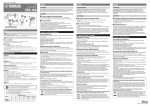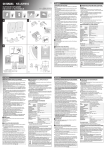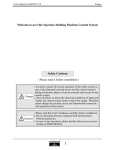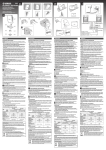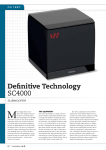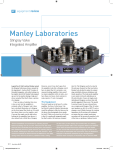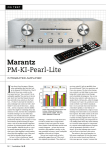Download Yamaha A-S700 - EXCELIA HIFI
Transcript
equipmenT review Yamaha A-S700 Integrated Amplifier Newport Test Labs Yamaha is now one of the only large multinational manufacturers that continues to offer an extensive range of high-quality two-channel amplifiers and if the incredible success of its flagship stereo amplifiers, the AS-2000 and AS-1000 are any indication, the other companies are already ruing the day they decided to exit the two-channel market. The good news for everyone else is that Yamaha is now offering even more of the same, in the shape of the A-S700, at less than half the cost of the awardwinning AS-1000 (it picked up a ‘Best Product Award 2008–9’ from the European Imaging and Sound Association). Power Output: Both channels driven into 8-ohm and 4-ohm non-inductive loads at 20Hz, 1kHz and 20kHz using High-Z speaker output setting. [Yamaha AS700] 22 | Australian Hi-Fi The Equipment Visually, the A-S700 is almost a clone of the flagship model A-S2000, with what appears to be an identical front-panel layout. However, when you investigate more closely, you will see that although the control locations are identical, different front panel controls are fitted to those locations. If you look at the photograph above, the two switches below the input selector are for ‘CD Direct’ and ‘Pure Direct’, whereas on the A-S2000 these front panel positions are used for phono stage switching (MC/MM) and audio muting. And whereas on the A-S700 the small rotary controls to the right of the headphone socket are for speaker selection (Off, A, B, A+B) and record output switching (Line 1/2/3, CD, Phono, Tuner), the two on the A-S2000 are for headphone volume and record output switching. Take your ruler to the amplifiers and you’ll find that although the A-S700’s front panel is the same width (435mm) and a little higher (151mm), it’s not nearly as deep (the A-S700 is only 382mm deep, compared to the A-S2000’s depth of 465mm). And if you resort to weighing the two amplifiers to differentiate them, you’ll discover that the A-S700 is only half the weight (10.9kg vs. 22.7kg). Despite this difference in weight (which would seem to indicate at least some economies in the A-S700’s power supply), Yamaha rates the power output of the A-S700 at 90- watts per channel (into 8Ω), which is exactly the same output it specifies for the A-S2000. To skip ahead of myself slightly, the reason Yamaha has been able to pull this trick is found on the rear panel, where a user-adjustable speaker impedance selector must be manually switched between ‘Low’ (for speakers with a nominal impedance rating lower than 6Ω) and ‘High’ (for speakers rated at 6Ω or higher). This switch adjusts the circuitry inside the amplifier for either maximum current drive or maximum voltage, so it’s an ‘either/or’ proposition, whereas the AS2000 doesn’t have a switch, so you get both maximum current and maximum voltage, no matter what the impedance of the speakers you connect. Activate the ‘Pure Direct’ switch on the AS700 and the signal at the CD input goes through the input selector switch and the volume control but bypasses the tone controls, loudness control and balance control. by means of a single button all fall ‘way short of what is most desirable. Yamaha’s rotary loudness control is the best implementation of loudness compensation, and I am pleased that it’s fitted to the A-S700. The A-S700 still sports bass and treble controls. Many audiophiles don’t favour these because when you use them, some distortion is inevitable, but my view is that if you need to add a little treble lift to compensate for an overly-damped room, or roll off some bass because you have no other option but to put your speakers too close to a wall for whatever reason, it’s better to correct the frequency response with tone control and put up with “Yamaha’s rotary loudness control is the best implementation of loudness compensation, and I am pleased that it’s fitted to the A-S700. frequencies varies depending on the volume level of the music you’re listening to. At normal listening levels, the ear hears a properly balanced sound, and detects the low frequencies in the correct balance with the midrange and high frequencies. However, if you turn the volume down, the ear’s low-frequency perception becomes worse, and percentage-wise, you’ll be hearing less bass than you should. (What’s actually happening is that the ear is discriminating in favour of the midrange, because this is where speech frequencies lie, but the end result is the same… you hear less bass.) Loudness controls attempt to rectify this physiological fact by boosting the level of the low bass sounds when you’re playing at low volumes. The loudness controls that do this a tiny increase in distortion than to endure an unbalanced frequency response. (Note, however, that I am talking about very small movements of the bass and treble controls away from the midway position. If you have to move either control further than the ‘10’ or ‘2’ o’clock positions you should instead be looking at correcting the underlying issues!) I was also pleased that the A-S700 also has a balance control. Even if you have your speakers correctly positioned so you get a perfect image at the listening position, this will only be true with well-recorded CDs, and I am always surprised at how many CDs are recorded hotter in one channel than the other, and thereby shift the image too far to the right or left. (I suspect the reason is that many recording studios do not check their monitor speakers’ accuracy as regularly as they should.) And when a recording is not correctly balanced, you will either need to adjust the balance control on your amplifier to ensure correct balance, or move your speakers. I know which I’d prefer to do! The A-S700 is supplied with a full-function remote control that will operate other Yamaha components as well. However, although the • High power output • Whisper-quiet noise levels • Lovely sound balance • Speaker terminals • Remote only comes in silver • Front panel marks easily amplifier is supplied in two different finishes (satin black or brushed aluminium), the remote control for both is brushed aluminium. In Use and Listening Sessions Setting up the A-S700 is relatively straightforward, but there are some things you do have to remember. The first of these is that if you choose the satin-black finish, you should make sure your hands are absolutely clean before unpacking and positioning the amplifier, because the surface shows fingerprints quite easily, and if you mark it, you will need to apply some elbow-grease to remove them. The second is that for whatever reason, I found the speaker terminals quite difficult to turn (perhaps because of their diameter and the proximity of the protective shrouds). Although they’re good quality terminals, they could have been improved, particularly given the AS700’s price. Luckily, the terminals will accept standard banana plugs, as well as dual Pomona plugs, so I’d suggest wiring up your speaker cables with either of these fittings rather than Newport Test Labs Activate the ‘CD Direct Amp’ switch and the signal at the CD input bypasses the input selector as well, so that only the volume control lies between it and the output. As you have probably realised from my description of the Record Output selector, the AS700 isn’t short of inputs! There are three Line inputs, a CD input, a Tuner input and a Phono input (this last being for a moving magnet phono cartridge only). The input selector is a rotary encoder type, with LEDs indicating the selected input. To the left of the input selector is a rotary loudness contour control. As most readers of Australian Hi-Fi Magazine will already know, the human ear’s sensitivity to low Power Output: Both channels driven into 8-ohm and 4-ohm non-inductive loads at 20Hz, 1kHz and 20kHz using Low-Z speaker output setting. [Yamaha AS700] using bare wire. Finally, you need to remember to set the speaker impedance switch before you start using the amplifier, and to do so with the amplifier switched OFF! (If you forget, and need to move the switch, you should switch the amplifier off, and then the mains power, before re-setting the switch.) The volume control had the slightly spongy Yamaha A-S700 Brand: Yamaha Model: A-S700 Category: Integrated Amplifier RRP: $1,099 Warranty: Two Years Distributor: Yamaha Music Australia Pty Ltd Address: Level 1, 99 Queensbridge Street Southbank, VIC 3006 T: 1300 739 411 T: (03) 9693 5111 F: (03) 9699 2332 E: avsales@gmx.yamaha.com W: www.yamahamusic.com.au Australian Hi-Fi | 23 equipmenT review Yamaha A-S700 Integrated Amplifier 24 | feel that is typical of motor-driven volume controls, however the benefit is that the control actually rotates when you press the volume ‘up’ and ‘down’ buttons on the remote, so you can always see the volume setting on the front panel. The input source selector has a lovely action under the fingers, thanks to the encoder circuitry, and the LEDs are bright, so you can always see what source you’ve selected from quite a distance away, but I was slightly perplexed that although the action of the control is contiguous, in that you can spin it in either direction without ever reaching an ‘end stop’, the actual switching stops once you have reached the Line 3 input when going anti-clockwise, and the Phono input when going clockwise. This isn’t a problem, it simply means that although it’s an encoder, it works like a mechanical selector. I imagined that perhaps this was deliberate, considering that the styling of the A-S700 echoes the styling of the amplifiers Yamaha was designing ‘way back in the ‘70s. After experimenting every which way with the Yamaha A-S700’s impedance selector and a variety of different loudspeakers, every one of which I knew the exact impedance of (thanks to graphs of the impedance moduluses, and lists of the actual measured ‘nominal’ need. The A-S700 is so powerful, in fact, that even with inefficient speakers in a large room I don’t think you’ll ever be hungering after more power than it can deliver. It really is an amazingly powerful amp! Even when you’re not running it full tilt (and you won’t be), the power that is available on tap means that the bass is really solid and well-defined, so that there is a real sense of authority in the lowest frequencies. More importantly, even if there’s a lot going on in the bass region, the power available means that there are no unwanted modulations of the very highest frequencies, so the treble sound is as pure as it is when there’s very little happening down low. But the bass isn’t just big, it’s also so rhythmic and bouncy that you don’t even start to question pace and timing: they’re right there… vibrant and on the go. Midrange sound is crystal-clear and beautifully transparent. There’s a lovely sense of clarity and ‘ease of listening’ that comes through at all times… though it is particularly obvious when auditioning lighter works that are heavy on human voice and just a few higher-pitched instruments (think typical ‘demo track’ at any hi-fi show). However, extended auditioning with complex orchestral and/or choral works will show that even when presented with such overall impedance supplied by Newport Test Labs), I eventually concluded that if you are using just a single pair of speakers with the A-S700, you should set the impedance selector to the ‘high’ position, even if the label on the rear of the speaker says ‘4Ω’. It is only if you have connected TWO pairs of speakers to the A-S700, and will be using the A+B mode regularly that I would recommend using the ‘Low’ position. (I know this is somewhat at odds with Yamaha’s recommendation, but I think Yamaha is playing it super-safe.) As a result of my investigations, all my listening sessions were conducted with the A-S700’s impedance switch set to the ‘High’ position. The A-S700 proved to be very powerful, as it was easily able to over-power even the largest and most inefficient speakers I had available, in the process creating louder sound pressure levels than most people will ever sonic difficulties, the sound of the Yamaha AS700 doesn’t ever become compressed, or even congested, so that it’s very easy to appreciate the multiple threads that are usually woven by composers, as well as the professionalism of the musicians in teasing out those threads into a performance. The air around the high-frequencies is a joy. Individual notes seem to suspend themselves just long enough to allow you to enjoy the harmonic relationships with what lies below, yet not hang around so long that they confuse the issue by extending into unrelated multi-layered puffery. Sonic purity was at the highest level. What you certainly won’t hear from the Yamaha A-S700 is any unwanted electronic noise, because Yamaha’s engineers have excelled themselves. There is absolutely no background circuit noise or hum at all. And, al- Australian Hi-Fi LAB Readers interested in a full technical appraisal of the performance of the Yamaha A-S700 Integrated Amplifier should continue on and read the LABORATORY REPORT published on the following pages. Readers should note that the results mentioned in the report, tabulated in performance charts and/or displayed using graphs and/or photographs should be construed as applying only to the specific sample tested. though I could hear tiny differences between the ‘normal’ mode and the two direct modes when music was playing, I couldn’t hear any differences at all in noise levels between the three when no music was playing, even when the volume level was advanced. This ultralow noise capability, combined with the high power output level, and the speed with which the amplifier was able to respond to even the fastest transients, meant that the overall sound is highly dynamic, which in turn gave musical performances the lift they need to propel them to the upper levels of the reproduced sound stakes. Conclusion I can unhesitatingly recommend Yamaha’s AS700 to anyone who’s after superior sound reproduction from an integrated amplifier, not just because of its sound quality and overall performance, but also because Yamaha has such a great reputation for its product quality and its customer support… in the unlikely event that you’ll ever need it, which I doubt you ever will. greg borrowman TesT results equipmenT review Yamaha A-S700 Integrated Amplifier Laboratory Test Results The Dr Jekyll and Mr Hyde nature of the Yamaha A-S700’s power supply/output stage management has meant that when it’s driving loads greater than 8Ω, using the ‘High’ setting of the impedance selector, its power output is very high indeed. As you can see from the tabulated figures, and also from the bar graphs accompanying the main part of the review, when only a single channel is driven into a 4Ω load, using a 1kHz test signal, the A-S700 puts out a stunning 256-watts continuous per channel. Under such load conditions the power output drops a little at the frequency extremes, but it’s still greater than 200-watts per channel. Using the usual ‘both channels driven into 8Ω’ criteria that is the accepted industry standard for measuring power output, the Yamaha A-S700 delivers a minimum power output of 115-watts per channel at 20kHz, but can manage a little more at higher frequencies, to the tune of 130-watts at 1kHz and 127watts at 20kHz. The only situation in which the Yamaha didn’t deliver at least 90-watts per channel into the test loads was when its impedance selector was set to ‘Low’ and it was being driven by a very low-frequency (20Hz) test signal, under which conditions it fell a little shy, returning just 82-watts per channel, which as you can see by comparing the dBW columns, is just 0.4dB down on rated output. Total harmonic distortion was very low, as you can see on Graphs 1 through 4, which show THD at an output of 1-watt into both 4Ω and 8Ω loads, and THD at 90-watts into an 8Ω load, and at 105-watts across a 4Ω load. At one watt output, the primary harmonic distortion component is the second harmonic, and it’s around 90dB down (0.003%) when driving 8Ω loads and a little higher (–85dB/0.005%) when the amplifier is driving a 4Ω load. The third harmonic is sitting at around –95dB (0.001% THD) for both loads. All higher distortion components are more than 100dB down (0.001%) though there are more higherorder components visible when it’s driving 4Ω than when it’s driving 8Ω. Overall THD+N was measured at just 0.006%. Note that on both graphs, the noise floor is sitting right down at –120dB above the fundamental (at 1kHz), while even at the extreme left of the graph, where you’d expect to find power supply noise, the LF noise is at 99dB and 95dB respecdBFS 0.00 Newport Test Labs Yamaha A-S700 Integrated Amplifier - Test Results Serial No: Y011018TV Test Measured Result Units/Comments Frequency Response @ 1 watt 2.5Hz–91kHz –1dB Frequency Response @ 1 watt 1.2Hz–159kHz –3dB Channel Separation 86dB / 64dB / 40dB (20Hz/1kHz/20kHz) Channel Balance 0.076dB @ 1kHz Interchannel Phase 0.27 / 0.03 / 0.59 deg (20Hz/1k/20k) THD+N 0.0006% / 0.004% 1 watt/rated o/p S/N Ratio (unweighted/weighted) 87dB/93dB dB re 1 watt output S/N Ratio (unweighted/weighted) 98dB/103dB dB re rated output Input Sensitivity (CD input) 18.4mV/177mV (1 watt/rated output) Output Impedance 0.0371Ω OC = 2.8292V Damping Factor 215 @ 1kHz Power Consumption 0.82/23 watts Standby/On Power Consumption 53 watts /303 watts 1-watt/Rated O/P Mains Voltage Variation 242–252 volts Min–Max Yamaha A-S700 Integrated Amplifier - Test Results for Power Output Channels Driven Load (Ω) 20Hz (watts) 20Hz (dBW) 1kHz (watts) 1kHz (dBW) 20kHz (watts) 20kHz (dBW) 1 8Ω (HiZ) 145 21.6 153 21.8 153 21.8 2 8Ω (HiZ) 115 20.6 130 21.1 127 21.0 1 4Ω (HiZ) 240 23.8 256 24.0 232 23.6 2 4Ω (HiZ) 162 22.0 190 22.7 182 22.6 1 8Ω (LoZ 100 20.0 100 20.0 100 20.0 2 8Ω (LoZ) 82 19.1 90 19.5 90 19.5 1 4Ω (LoZ) 156 21.9 169 22.3 167 22.2 2 4Ω (LoZ) 115 20.6 135 21.3 126 21.0 Note: Figures in the dBW column represent the output level, in decibels, referred to one watt output. tively. At higher outputs, the ‘skirts’ around the fundamental show that these output levels are stretching the limits of the A-S700’s power supply’s ability to deliver both voltage and current, but despite this, the harmonic distortion components are still very low (all more than 90dB down) and low-order. Note the noise floor has dropped even lower over most of the graph, though at the extreme left, the stress on the power supply has resulted in increased power supply noise. However, as you can see from the overall signal-to-noise ratios, the Yamaha A-S700 is an exceptionally quiet integrated amplifier, returning a best result of –103dB A-weighted, referenced to rated output. Referenced to 1-watt output (which allows easy comparisons with other amplifiers… dBFS 0.00 Newport Test Labs or at least easy if their S/N ratios are referenced to the same output) the Yamaha’s S/N was measured by Newport Test Labs as 93dB. CCIF IMD was also very low, as you can see for yourself from Graph 5. There is very little regenerated signal at 1kHz, and even the upper sidebands at 18kHz and 21kHz are around 95dB down. Frequency response was extended, with the A-S700 returning a result of 1.2Hz to 159kHz ±1.5dB. Across the audio band it was superbly flat, as you can see from Graph 9. On this graph, Newport Test Labs has compared the CD Direct circuit path with that of the Pure Direct. As you can see, the Pure Direct trace is the flatter of the two, due to the CD Direct response rising around 1.5dB below 20Hz. This dBFS 0.00 -20.00 -20.00 -20.00 -40.00 -40.00 -40.00 -60.00 -60.00 -60.00 -80.00 -80.00 -80.00 -100.00 -100.00 -100.00 -120.00 -120.00 -120.00 -140.00 -140.00 0.00 Hz 4000.00 8000.00 12000.00 16000.00 20000.00 Graph 3: Total harmonic distortion (THD) at 1kHz referenced to 90-watts across an 8-ohm non-inductive load using high-Z output impedance setting. [Yamaha A-S700 Integrated Amplifier] 26 | Australian Hi-Fi Newport Test Labs -140.00 0.00 Hz 4000.00 8000.00 12000.00 16000.00 20000.00 Graph 2: Total harmonic distortion (THD) at 1kHz referenced to 1-watt across a 4-ohm non-inductive load using high-Z output impedance setting. [Yamaha A-S700 Integrated Amplifier] 0.00 Hz 4000.00 8000.00 12000.00 16000.00 20000.00 Graph 3: Total harmonic distortion (THD) at 1kHz referenced to 90-watts across an 8-ohm non-inductive load using high-Z output impedance setting. [Yamaha A-S700 Integrated Amplifier] TesT results equipmenT review Yamaha A-S700 Integrated Amplifier lift is so small—and at such a low frequency— that it would not be audible. What might just be audible is the slight increase in level you’d hear when switching from CD Direct to Pure Direct or from the ordinary CD path to the Pure Direct path. As you can see, the flattest, most linear response is provided via the Pure Direct path, closely followed by the CD Direct path…just as you’d expect, really! Channel separation was not the A-S700’s strong point, as you can see from the traces crossing Graph 7. Channel separation is a good 86dB at 20Hz and still a very respectable 64dB at 1kHz, but it eventually decreases to just 40dB at 20kHz. This is more than adequate to ensure perfect stereo imaging but shows there’s likely a little capacitive coupling inside the amplifier. HF channel separation improved when either of the direct modes was deployed. The graph showing the action of Yamaha’s loudness contour shows that Yamaha is compensating for both the low- and high-frequency roll-off issues that affect the human ear. (Some loudness contours address only the low-frequency hearing problem.) The curve’s shape is excellent, giving a maximum 18dB boost at low frequencies that is nicely shelved at 40Hz and just on 8dB of boost at high frequencies, shelved at 20kHz. The action of the tone controls is also beautifully constrained, with the A-S700’s circuit offering around +12dB of boost and –12dB of cut. If you use extreme settings of the controls there will be an audible effect on the midrange level, but that’s pretty much what I’d expect. The input sensitivities are spot-on for interfacing with other hi-fi components, while the very high damping factor shows that the Yamaha A-S700’s own ‘sound’ will not change at the whim of the speakers you connect, so you will be hearing the true response of whatever speakers are connected. The square wave performance is excellent, with the 100Hz waveform showing the tilt expected from a frequency response that does not extend to d.c. but no evidence of phase inaccuracies. The 1kHz waveform is close to perfect (a little snip off the leading edge mars it) while the 10kHz waveform reflects the fact that the Yamaha AS700’s frequency response is only 3dB down at 159kHz. There is quite a deal of overshoot and some ringing evident when driving a severe capacitive load, but the amplifier’s output stage settles down quickly and is demonstrably completely stable. I was pleased to find that the Yamaha AS700’s standby power consumption is so low that it already meets the Australian laws that will come into force two years from now. However you can see that the circuit is also relatively efficient, as the amplifier draws just a shade over 300-watts from the mains when operating at its maximum output and mostly will draw less than 100-watts even when it’s working hard. Overall, I’d have to say that Yamaha’s A-S700 delivers a truly outstanding Steve Holding level of performance. 28 | Australian Hi-Fi dBFS 0.00 Newport Test Labs dBFS 0.00 Newport Test Labs -10.00 -20.00 -20.00 -30.00 -40.00 -40.00 -50.00 -60.00 -60.00 -80.00 -70.00 -80.00 -100.00 -90.00 -100.00 -120.00 -110.00 -120.00 -140.00 0.00 Hz 4000.00 8000.00 12000.00 16000.00 0.00 Hz 20000.00 4000.00 8000.00 12000.00 16000.00 20000.00 24000.00 28000.00 Graph 5: Intermodulation distortion (CCIF-IMD) using test signals at 19kHz and 20kHz, referenced to a 1-watt output (at 0dB) across an 8-ohm non-inductive load. [Yamaha A-S700 Int. Amplifier] Graph 4 Total harmonic distortion (THD) at 1kHz referenced to 105-watts across a 4-ohm non-inductive load using high-Z output impedance setting. [Yamaha A-S700 Integrated Amplifier] dBr dBr 10.00 Newport Test Labs Newport Test Labs 0.00 5.00 -20.00 0.00 -40.00 -5.00 -60.00 -10.00 -15.00 -80.00 -20.00 -100.00 -25.00 -120.00 -30.00 10.00 Hz 100.00 1000.00 10000.00 40000.00 10.00 Hz Graph 6: Loudness control action referenced to 0dB at 1kHz. [Yamaha A-S700 Integrated Amplifier] dBr 15.00 Newport Test Labs 100.00 1000.00 10000.00 40000.00 Graph 7: Channel separation referenced to a 1-watt output (at 0dB) across and 8-ohm non-inductive load using high-Z output impedance setting. [Yamaha A-S700 Integrated Amplifier] dBr 1.00 Newport Test Labs 10.00 0.50 5.00 0.00 0.00 -5.00 -0.50 -10.00 -1.00 -15.00 10.00 Hz 100.00 1000.00 10000.00 40000.00 Graph 8: Tone control action referenced to 0dB at 1kHz. [Yamaha A-S700 Integrated Amplifier] 10.00 Hz 100.00 1000.00 10000.00 30000.00 Graph 9: Frequency response of CD input via CD Direct circuit path (red trace), via Pure Direct circuit path (black trace), and through the standard CD input with both direct paths switched off (blue trace). All measured using 8-ohm non-inductive load. [Yamaha A-S700.]





